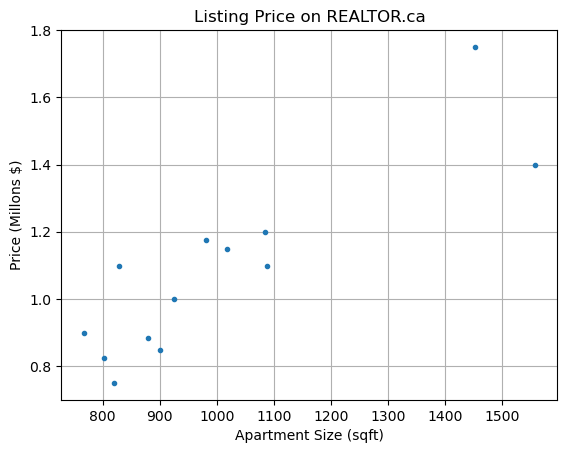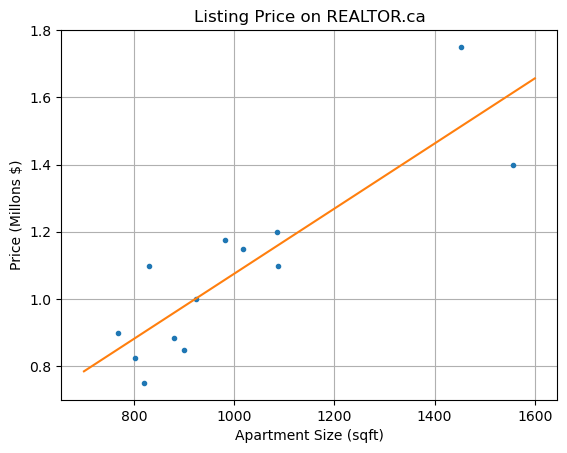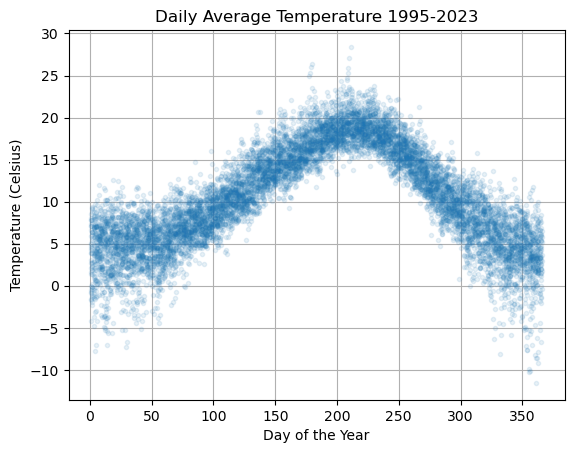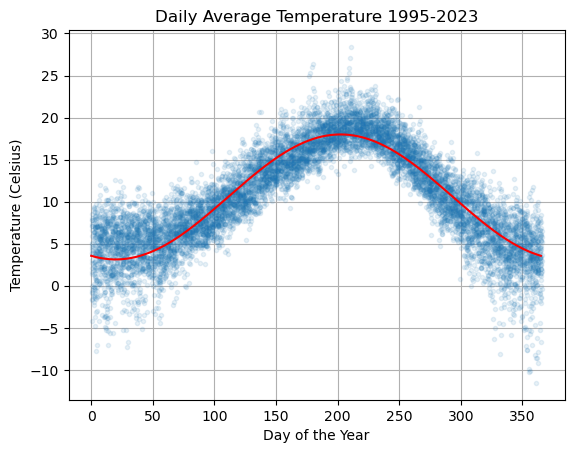Least Squares#
import numpy as np
import matplotlib.pyplot as plt
import scipy.linalg as la
import pandas as pd
Residual Sum of Squares#
Let \((\mathbf{x}_1,y_1),\dots,(\mathbf{x}_N,y_N)\) be a data set of \(N\) observations where each \(\mathbf{x}_i = (x_{i,1},\dots,x_{i,p})\) is a vector of values of the independent variables \(x_1,\dots,x_p\). Consider a linear regression model
The residual sum of squares is the cost function
The goal of least squares linear regression is to compute parameters \(\beta_0,\beta_1,\dots,\beta_p\) which minimize \(RSS\).
Normal Equations#
Note that the expression for \(RSS\) above can be written in vector form using matrix multiplication
where
The vector \(\boldsymbol{\beta}\) which minimizes \(RSS\) is the unique solution of the normal equations
Let’s see why this is true. Note that \(X \boldsymbol{\beta}\) is a vector in the column space of \(X\) therefore the distance \(|| \mathbf{y} - X \boldsymbol{\beta} ||\) is minimized when the line from \(\mathbf{y}\) to \(X\boldsymbol{\beta}\) is orthogonal to the column space of \(X\). In other words, we want to find \(\boldsymbol{\beta}\) such that \(\mathbf{y} - X \boldsymbol{\beta}\) is in the nullspace of \(X^T\) which leads to the equation \(X^T(\mathbf{y} - X \boldsymbol{\beta}) = 0\) and finally \(X^T X \boldsymbol{\beta} = X^T \mathbf{y}\).
Example: Real Estate Prices#
The data below was collected from REALTOR.ca for 2-bedroom apartments for sale in the Kitsilano neighborhood of Vancouver. The dependent variable \(y\) is the listing price and the independent variable \(x\) is the apartment size (in square feet).
x = [1557,1452,767,900,1018,802,924,981,879,819,829,1088,1085]
y = [1.398,1.750,0.899,0.848,1.149,0.825,0.999888,1.175,0.885,0.749888,1.098,1.099,1.198]
plt.plot(x,y,'.')
plt.title('Listing Price on REALTOR.ca')
plt.xlabel('Apartment Size (sqft)'), plt.ylabel('Price (Millons $)'), plt.grid(True)
plt.show()

Choose a simple linear regression model for the data \(y = \beta_0 + \beta_1 x + \varepsilon\). Construct the matrix \(X\):
X = np.column_stack([np.ones(len(x)),x])
X
array([[1.000e+00, 1.557e+03],
[1.000e+00, 1.452e+03],
[1.000e+00, 7.670e+02],
[1.000e+00, 9.000e+02],
[1.000e+00, 1.018e+03],
[1.000e+00, 8.020e+02],
[1.000e+00, 9.240e+02],
[1.000e+00, 9.810e+02],
[1.000e+00, 8.790e+02],
[1.000e+00, 8.190e+02],
[1.000e+00, 8.290e+02],
[1.000e+00, 1.088e+03],
[1.000e+00, 1.085e+03]])
Solve the normal equations:
beta = la.solve(X.T@X,X.T@y)
beta
array([0.10620723, 0.00096886])
Plot the linear regression model with the data:
xs = np.linspace(700,1600)
ys = beta[0] + beta[1]*xs
plt.plot(x,y,'.',xs,ys)
plt.title('Listing Price on REALTOR.ca'), plt.grid(True)
plt.xlabel('Apartment Size (sqft)'), plt.ylabel('Price (Millons $)')
plt.show()

The coefficient \(\beta_1 = 0.00096886\) suggests that the listing price of a 2-bedroom apartment increases by \(968.86\) dollars per square foot.
Example: Temperature#
The file temperature.csv includes daily average temperature measured at the Vancouver Airport from 1995 to 2023 (see vancouver.weatherstats.ca). Let’s import the data, look the first few rows and then plot the average tempearture versus day of the year.
df = pd.read_csv('temperature.csv')
df.head()
| day | month | year | dayofyear | avg_temperature | |
|---|---|---|---|---|---|
| 0 | 13 | 4 | 2023 | 103 | 7.10 |
| 1 | 12 | 4 | 2023 | 102 | 5.19 |
| 2 | 11 | 4 | 2023 | 101 | 8.00 |
| 3 | 10 | 4 | 2023 | 100 | 7.69 |
| 4 | 9 | 4 | 2023 | 99 | 9.30 |
df.tail()
| day | month | year | dayofyear | avg_temperature | |
|---|---|---|---|---|---|
| 9995 | 1 | 12 | 1995 | 335 | 6.40 |
| 9996 | 30 | 11 | 1995 | 334 | 9.15 |
| 9997 | 29 | 11 | 1995 | 333 | 11.50 |
| 9998 | 28 | 11 | 1995 | 332 | 9.75 |
| 9999 | 27 | 11 | 1995 | 331 | 6.90 |
plt.plot(df['dayofyear'],df['avg_temperature'],'.',alpha=0.1,lw=0)
plt.title('Daily Average Temperature 1995-2023')
plt.xlabel('Day of the Year'), plt.ylabel('Temperature (Celsius)'), plt.grid(True)
plt.show()

Let \(T\) by the temperature and let \(d\) be the day of the year. Define a regression model of the form
Note that if we rewrite the variables as \(y = T\), \(x_1 = \cos(2 \pi d/365)\) and \(x_2 = \sin(2 \pi d/365)\) then we see that this is indeed a linear regression model
Construct the corresponding data matrix \(X\) and compute the coefficient vector \(\boldsymbol{\beta}\).
N = len(df)
d = df['dayofyear']
T = df['avg_temperature']
X = np.column_stack([np.ones(N),np.cos(2*np.pi*d/365),np.sin(2*np.pi*d/365)])
beta = la.solve(X.T@X,X.T@T)
ds = np.linspace(0,365,500)
Ts = beta[0] + beta[1]*np.cos(2*np.pi*ds/365) + beta[2]*np.sin(2*np.pi*ds/365)
plt.plot(df['dayofyear'],df['avg_temperature'],'.',alpha=0.1,lw=0)
plt.plot(ds,Ts,'r'), plt.grid(True)
plt.title('Daily Average Temperature 1995-2023')
plt.xlabel('Day of the Year'), plt.ylabel('Temperature (Celsius)')
plt.show()

